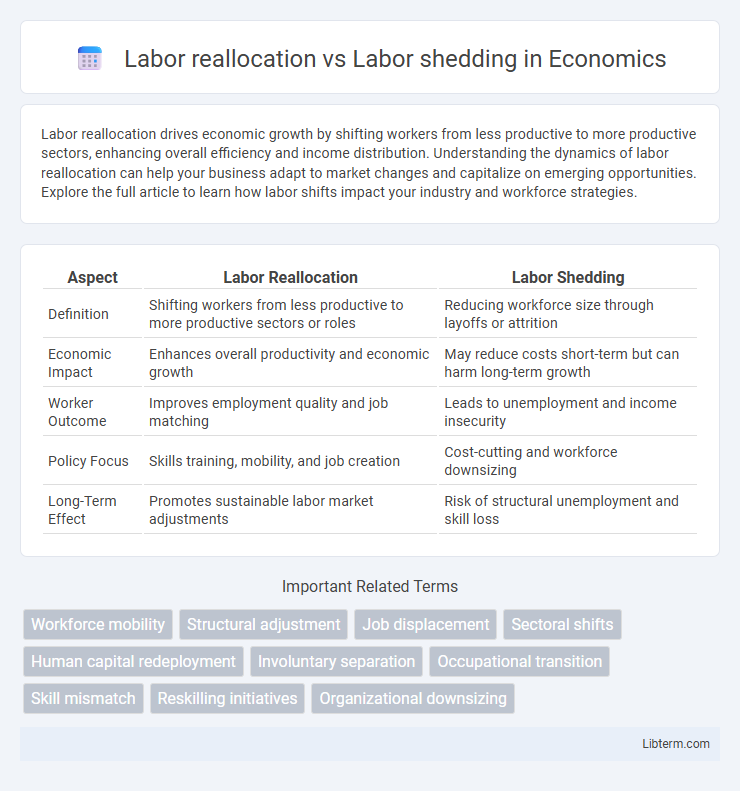Labor reallocation drives economic growth by shifting workers from less productive to more productive sectors, enhancing overall efficiency and income distribution. Understanding the dynamics of labor reallocation can help your business adapt to market changes and capitalize on emerging opportunities. Explore the full article to learn how labor shifts impact your industry and workforce strategies.
Table of Comparison
| Aspect | Labor Reallocation | Labor Shedding |
|---|---|---|
| Definition | Shifting workers from less productive to more productive sectors or roles | Reducing workforce size through layoffs or attrition |
| Economic Impact | Enhances overall productivity and economic growth | May reduce costs short-term but can harm long-term growth |
| Worker Outcome | Improves employment quality and job matching | Leads to unemployment and income insecurity |
| Policy Focus | Skills training, mobility, and job creation | Cost-cutting and workforce downsizing |
| Long-Term Effect | Promotes sustainable labor market adjustments | Risk of structural unemployment and skill loss |
Understanding Labor Reallocation and Labor Shedding
Labor reallocation involves shifting workers from declining sectors to growing industries to optimize workforce productivity and support economic transformation, while labor shedding refers to outright job losses often due to layoffs or automation without immediate redeployment. Understanding labor reallocation requires examining strategies such as retraining programs, mobility incentives, and sectoral adjustments that facilitate smooth transitions for displaced workers. Labor shedding analysis focuses on the socio-economic impacts of unemployment spikes and necessitates policies addressing income support and labor market reintegration.
Key Differences Between Labor Reallocation and Labor Shedding
Labor reallocation involves redistributing employees within an organization to optimize productivity, often by shifting workers to roles that better match their skills or meet changing business needs, whereas labor shedding refers to the permanent reduction of workforce through layoffs or terminations to cut costs. Labor reallocation aims to retain talent and improve operational efficiency without decreasing headcount, while labor shedding prioritizes immediate cost savings at the expense of workforce size. Key differences include the impact on employee morale, organizational flexibility, and long-term strategic goals, with labor reallocation supporting adaptability and labor shedding often signaling financial distress or restructuring.
Economic Drivers of Labor Reallocation
Labor reallocation involves shifting workers across industries or occupations to optimize productivity, driven by factors such as technological advancements, globalization, and changing consumer demand. Economic drivers include innovation-induced structural changes, labor market flexibility, and investment in workforce skills that facilitate transitions. Unlike labor shedding, which reduces employment levels, reallocation supports economic growth by aligning labor supply with evolving market needs.
Causes and Consequences of Labor Shedding
Labor shedding occurs primarily due to economic downturns, technological automation, and organizational restructuring aimed at cost reduction. The consequences include increased unemployment, reduced household income, and potential declines in consumer demand, which can further slow economic growth. Labor reallocation, by contrast, involves shifting workers to sectors with higher productivity or growing demand, promoting long-term economic resilience and improved labor market efficiency.
Impact on Workforce Productivity
Labor reallocation boosts workforce productivity by shifting employees to roles that better match their skills, enhancing efficiency and reducing downtime. Labor shedding, while cutting costs by reducing headcount, often undermines productivity due to loss of expertise and increased workload on remaining staff. Strategic labor reallocation supports sustainable growth through skill optimization, whereas labor shedding risks long-term performance decline.
Labor Market Adjustments in Different Industries
Labor reallocation involves shifting workers between industries or sectors to optimize employment based on evolving market demands, while labor shedding refers to outright job cuts often driven by economic downturns or technological disruption. Industries with rapid technological advancements, such as manufacturing and information technology, experience higher rates of labor reallocation as workers retrain for new roles, whereas sectors like retail and hospitality commonly resort to labor shedding during economic contractions. Effective labor market adjustments depend on policies supporting workforce reskilling and mobility to mitigate unemployment and enhance industry adaptability.
Policy Responses to Labor Reallocation
Policy responses to labor reallocation prioritize reskilling programs and job matching services to facilitate smooth transitions across sectors and occupations. Active labor market policies (ALMPs), such as vocational training and wage subsidies, reduce frictional unemployment caused by industry shifts and technological advancements. Targeted support for displaced workers enhances workforce adaptability while minimizing long-term unemployment risks associated with labor shedding.
Social Implications of Labor Shedding
Labor shedding, characterized by permanent job losses or layoffs, often leads to increased unemployment rates, reduced household income, and heightened economic insecurity for affected workers. This process disproportionately impacts vulnerable populations, exacerbating income inequality and social stratification within communities. The social implications extend to mental health challenges and decreased social cohesion, as displaced workers face difficulties reintegrating into the labor market and sustaining their livelihoods.
Case Studies: Labor Reallocation vs Labor Shedding
Case studies reveal labor reallocation enhances organizational flexibility by shifting workers to high-demand roles, improving productivity and employee retention. In contrast, labor shedding, or workforce reduction, often leads to short-term cost savings but risks long-term talent loss and reduced morale. Firms employing labor reallocation strategies show higher adaptability to market fluctuations compared to those relying on labor shedding.
Strategies for a Resilient Labor Market
Labor reallocation involves shifting workers to new roles or industries, boosting workforce adaptability and reducing unemployment during economic shifts. Labor shedding, which entails job cuts, often increases short-term unemployment and economic instability. Strategies for a resilient labor market emphasize retraining programs, flexible work arrangements, and targeted support to facilitate smooth transitions for displaced workers.
Labor reallocation Infographic

 libterm.com
libterm.com